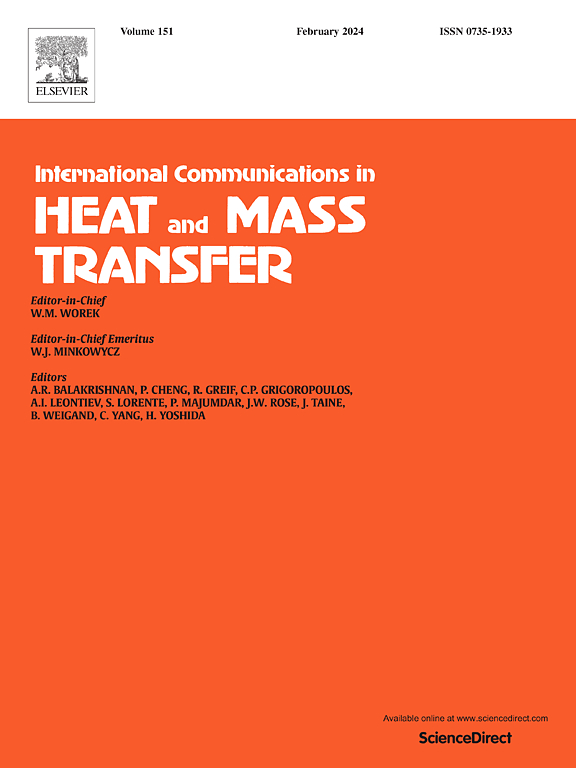叶片间隙高度对强、弱反应叶栅叶顶对流传热特性的影响
IF 6.4
2区 工程技术
Q1 MECHANICS
International Communications in Heat and Mass Transfer
Pub Date : 2025-07-01
DOI:10.1016/j.icheatmasstransfer.2025.109290
引用次数: 0
摘要
采用萘升华技术和油膜法,研究了h/s(叶顶间隙高度/叶跨)对出口-进口速度比(EIVR) = 1.2(弱反应)和2.4(强反应)涡轮叶片叶栅传热(质)和叶顶近壁流动的影响。除了EIVR外,它们具有几乎相同的进口流动条件和主要叶栅参数。结果表明:当EIVR = 2.4时,叶尖近壁面流动和前缘与中弦之间的换热存在沿弦方向的周期性变化;相反,EIVR = 1.2时几乎不存在弦向周期变化。无论EIVR如何,随着h/s的增加,Sh¯(面积平均叶尖Sherwood数)均呈现先增大后达到峰值再减小的趋势。EIVR越高,叶尖泄漏流越强,会使Sh¯增大,使Sh¯在更窄的叶尖间隙范围内出现增减趋势。EIVR = 2.4与EIVR = 1.2的Sh¯之比随着h/s持续减小,最终小于1。然而,无论h/s如何,EIVR = 2.4时的质量平均损失约为EIVR = 1.2时的2.5倍。本文章由计算机程序翻译,如有差异,请以英文原文为准。
Effects of tip gap height on tip convective heat (mass) transfer characteristics in turbine blade cascades of weak and strong reactions
Effects of h/s (tip gap height/blade span) on heat (mass) transfer and tip near-wall flow are investigated in turbine blade cascades of exit-to-inlet velocity ratio (EIVR) = 1.2 (weak reaction) and 2.4 (strong reaction), by using the naphthalene sublimation technique and oil film method. They have almost same inlet flow conditions and major cascade parameters except for EIVR. The results show that for EIVR = 2.4, there are chord-wise periodic changes of tip near-wall flow and heat transfer between the leading edge and mid-chord. On the contrary, the chord-wise periodic change is hardly found for EIVR = 1.2. Regardless of EIVR, (area-averaged tip Sherwood number) has a tendency to increase, to have a peak, and then to decrease, with increasing h/s. The stronger tip leakage flow for higher EIVR tends (i) to augment and (ii) to make the increasing-decreasing tendency of arise in a narrower tip gap range. The ratio of for EIVR = 2.4 to that for EIVR = 1.2 consistently decreases with h/s and is finally lower than unity. However, the mass-averaged loss for EIVR = 2.4 is about 2.5 times as high as that for EIVR = 1.2, regardless of h/s.
求助全文
通过发布文献求助,成功后即可免费获取论文全文。
去求助
来源期刊
CiteScore
11.00
自引率
10.00%
发文量
648
审稿时长
32 days
期刊介绍:
International Communications in Heat and Mass Transfer serves as a world forum for the rapid dissemination of new ideas, new measurement techniques, preliminary findings of ongoing investigations, discussions, and criticisms in the field of heat and mass transfer. Two types of manuscript will be considered for publication: communications (short reports of new work or discussions of work which has already been published) and summaries (abstracts of reports, theses or manuscripts which are too long for publication in full). Together with its companion publication, International Journal of Heat and Mass Transfer, with which it shares the same Board of Editors, this journal is read by research workers and engineers throughout the world.

 求助内容:
求助内容: 应助结果提醒方式:
应助结果提醒方式:


